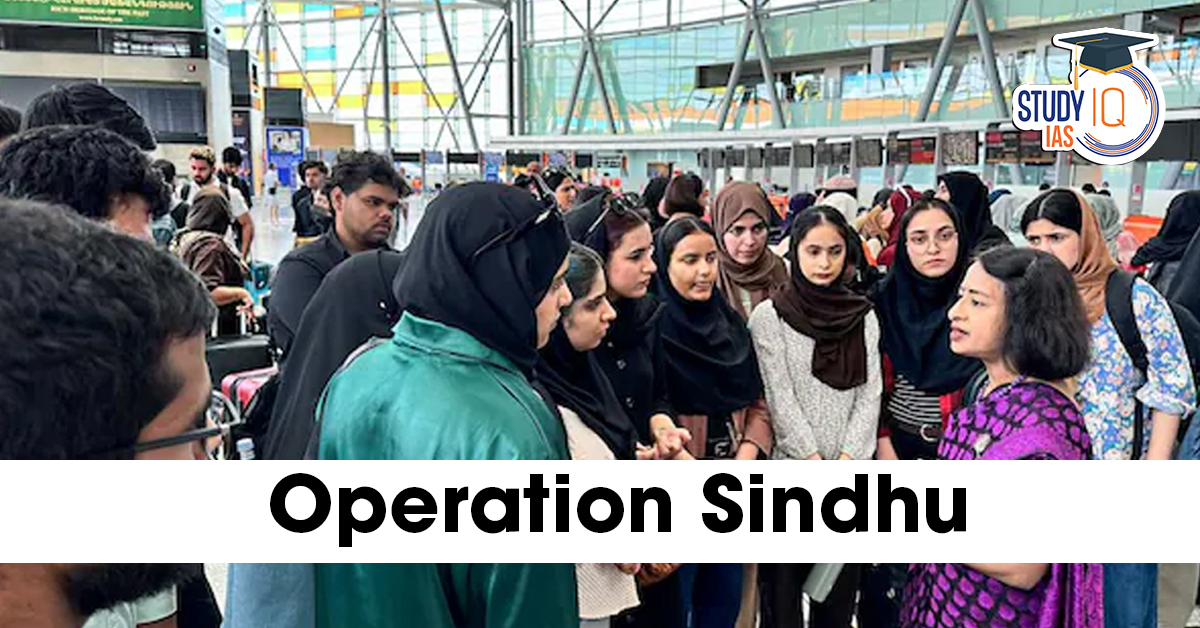Table of Contents
The military tension between Iran and Israel has seen a sharp rise in recent weeks, with airstrikes and attacks reported across major Iranian cities. The capital city Tehran and northern Iran have witnessed significant hostilities, prompting India to take immediate action to protect over 4,000 Indian nationals, many of whom are medical students and professionals.
What is Operation Sindhu?
Operation Sindhu is an emergency evacuation initiative launched by the Government of India on June 18, 2025, to evacuate Indian nationals, primarily students, stranded in war-affected Iran due to the escalating conflict between Iran and Israel.
With over 4,000 Indian nationals in Iran—many of whom are students—the operation underscores India’s unwavering commitment to protecting its citizens abroad during geopolitical crises.
The Iran-Israel Escalation and Threat to Indians
The Middle East, especially West Asia, remains one of the most volatile regions in the world. In recent weeks, tensions between Iran and Israel have escalated into direct military strikes, drone attacks, and missile exchanges. Key Iranian cities, including Tehran, Mashhad, and areas in the northern provinces, have witnessed explosions and aerial attacks, leading to growing insecurity among foreign nationals.
With over 4,000 Indian citizens residing in Iran—more than 2,000 being students, primarily studying medicine—the Indian government was quick to activate its crisis management machinery.
India’s Population in Iran
Approximately 4,000 Indian nationals reside in Iran, with about half being students enrolled mainly in medical colleges across Tehran and northern cities. Many others are professionals, including engineers, businessmen, and workers.
Given the deteriorating security scenario and direct threats from air raids—one of which struck a medical student dormitory on Keshavarz Street in Tehran, injuring some Indian students—India swiftly mobilized its diplomatic resources to safeguard its citizens.
Launch and Execution of Operation Sindhu
Planning and Coordination
-
The Ministry of External Affairs (MEA) in New Delhi, alongside the Indian Embassy in Tehran, coordinated a multi-layered evacuation plan.
-
Diplomats liaised closely with Iranian authorities to secure safe passage corridors for Indian nationals.
-
Armenia was identified as a transit point due to its geographical proximity and neutral stance.
-
The Indian Missions in both Iran and Armenia managed the logistics of overland evacuation and airlift operations.
Phase 1: The First Rescue Flight
-
On June 17, 2025, Indian students in northern Iran were transported by road to the Armenian border under tight security supervision.
-
They crossed into Armenia safely and were transported to Zvartnots International Airport, Yerevan.
-
On June 18 at 14:55 IST, a special chartered flight departed from Yerevan, carrying 110 Indian students, mostly from medical colleges, bound for New Delhi.
-
The flight landed in the early hours of June 19, 2025, marking the successful completion of the operation’s initial phase.
Incidence of Student Injuries in Tehran
Amid these evacuation efforts, a missile or drone strike hit a dormitory housing medical students on Keshavarz Street, Tehran, reportedly injuring several Indian students. The incident heightened urgency for India’s evacuation plans.
-
The Iranian Foreign Ministry confirmed close coordination with Indian diplomats to assist injured students.
-
India has not publicly commented on casualties but continues to prioritize medical aid and evacuation.
Diplomatic Cooperation and Challenges
The success of Operation Sindhu reflects significant diplomatic coordination:
-
Iran’s Government: Despite being a party to the conflict, Iran extended cooperation, facilitating the safe movement of Indian nationals out of high-risk zones.
-
Armenia’s Role: Provided a secure transit hub for Indians crossing the border and helped coordinate air evacuation.
-
India’s Diplomatic Response: Demonstrates India’s growing influence and ability to negotiate humanitarian corridors even amid geopolitical tensions.
Challenges included:
-
Navigating through a conflict zone with dynamic frontlines.
-
Ensuring the safety of evacuees during road transit across international borders.
-
Coordinating between multiple governments amid diplomatic sensitivities.
Support Mechanisms for Indian Nationals
-
The Indian Embassy in Tehran operates a 24×7 emergency helpline, assisting nationals in distress.
-
A dedicated MEA Control Room in New Delhi provides round-the-clock coordination and information dissemination.
-
Emergency contact numbers for various Iranian cities are actively publicized for ease of communication.
Past Evacuation Missions by India: A Track Record
| Operation | Year | Conflict Zone | People Evacuated |
|---|---|---|---|
| Operation Sindhu | 2025 | Ongoing evacuation from war-hit Iran | |
| Operation Kaveri | 2023 | Sudan Civil War | 3,800+ |
| Operation Ajay | 2023 | Return of Indians from Israel during conflict | |
| Operation Ganga | 2022 | Evacuation of Indians from Ukraine war zones | 20,000+ |
| Operation Devi Shakti | 2021 | Taliban takeover in Afghanistan | 700+ |
| Vande Bharat Mission | 2020 | Evacuation of Indians stranded abroad during COVID-19 | |
| Operation Raahat | 2015 | Yemen Crisis | 4,600+ Indians + 900 foreigners |
| Operation Sukoon | 2006 | Lebanon-Israel War | 2,280 Indians |
Future Plans
The Indian government plans subsequent evacuation phases to rescue more nationals, including students and other vulnerable groups. The MEA has reiterated its commitment to:
-
Continue assistance in moving Indian citizens from hostile zones to safer regions within Iran.
-
Conduct further airlifts or land evacuations as security conditions permit.
Strategic and Humanitarian Significance
-
Showcases India’s Diaspora Policy: Reflects India’s increasing focus on proactive protection of its overseas citizens.
-
Boosts India’s Global Image: Highlights India’s capability for rapid humanitarian intervention.
-
Strengthens West Asia Relations: Maintains India’s balanced approach in a sensitive region.
-
Adds to India’s Crisis Management Portfolio: Joins earlier efforts like Operation Ganga (Ukraine 2022) and Operation Devi Shakti (Afghanistan 2021).
Operation Sindhu is a pivotal example of India’s commitment to protecting its diaspora amid regional instability. It reflects India’s diplomatic maturity and operational readiness to respond to crises abroad, ensuring that the safety of its citizens remains paramount even in complex geopolitical environments.


 Protection of the Aravalli Range: Import...
Protection of the Aravalli Range: Import...
 Viksit Bharat Shiksha Adhishthan Bill 20...
Viksit Bharat Shiksha Adhishthan Bill 20...
 Jumping Genes: The Revolutionary Discove...
Jumping Genes: The Revolutionary Discove...

























